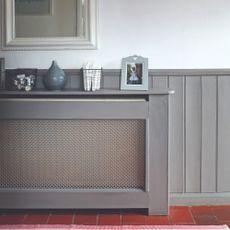Why is my radiator only hot at the top? Experts explain what it means and what you can do about it
If your radiator is cold at the bottom, we’ve got the info you need


Wondering why your radiator is only hot at the top but still cold at the bottom? You have a right to be concerned as it's a warning sign that something isn't working the way it should.
The price of how much it costs to run central heating for an hour has opened up our eyes to the importance of running an energy-efficient home - and radiators are a huge part of that. We rely on them to keep homes warm in winter, and ensuring that they’re running at their full capacity is vital to keep warm and bills low at the same time.
Of course, noticing that your radiator isn’t heating up is a major cause for concern, but what happens when a radiator is only cold at the bottom? This is a sure sign that something is wrong, and our experts explain why - along with tips on what you can do about it.
Why is my radiator only hot at the top?
‘It’s not the ideal time for your radiators not to be in full working order. With plenty of freezing weather likely over the next few months, it’s the perfect time to make sure all of your radiators are hot,’ explains Jack Coles, heating specialist at MyBuilder.com.
In fact, it’s generally considered good practice to check on your radiators every once in a while. The temperature of your radiators should ideally be the same at the top and the bottom - and the same temperature across your whole house.

However, sometimes things can go awry. As your boiler and your radiators get older, they require some occasional maintenance. It may be that you need to balance your radiators, or perhaps you need to bleed your radiators. By doing this, you should be able to maintain a constant temperature over the winter months.
These tasks won’t help if you have a build-up of dirt and sludge in your radiators, though. This dirt mixes with the rust and limescale that occurs as your boiler gets older and stops the hot water from flowing through your radiators properly. This will ultimately cause your radiator to be hot at the top but cold at the bottom.
Over time, this sludge will get progressively worse, which is why it’s important to take action as soon as you notice that the bottoms of your radiators are cold. You’ll need to step in to give it some care and attention, and the best way to deal with your radiator only being hot at the top is to flush your radiator.
Our guide on how to flush your radiators will offer a low-down on how to complete this common household task. Ultimately, your aim is to drain the radiator, take it off the wall, and completely flush out the dirt and debris before putting it back on your wall.
Most experts suggest using a professional to complete this process, though. ‘Nicholas Auckland, from Trade Radiators says, ‘To remove the sludge a power flush must be performed, this involves flushing your central heating system using a high volume of water and a chemical solution to dislodge the accumulated debris. A power flush must be performed by a professional plumber, it is far too advanced for your average DIYer.’

Nicholas Auckland is a heating and energy expert with over 10 years of experience in the industry, as well as the Managing Director of Trade Radiators. Nicholas is dedicated to finding the best heating solutions for every need, as well as optimising energy usage, reducing costs and helping others live with lower costing energy bills. Nicholas has become a trusted leader in the industry, frequently collaborating with the media and other partners to assist with cost of living issues and other home-related problems.
Signs that you need to flush your radiator
Wondering why your radiator is only hot at the top and cold at the bottom is a sure sign that your radiators need to be flushed. However, it’s not the only sign. These are the other signs you need to look out for:
- You’re having to bleed your radiators more often
- The bled radiator water is brown
- Radiators take a lot longer to heat up
- You have a noisy radiator
- The heat pump is leaking
If you spot any of these signs, it’s well worth flushing your radiators and seeing if this solves the problem. This is something you can do at home, but it’s important to note that if you’re unsure of what to do or the problem persists, you should seek the help of a professional.

Why you should flush a radiator
Flushing a radiator may be something you’d put at the bottom of your to-do list, but there are so many reasons why you should flush a radiator as soon as you spot the signs. First and foremost, it should stop your radiator from being cold at the bottom.
Nicholas adds, ‘To prevent sludge from recurring I recommend that homeowners have their system power flushed every 2 to 3 years. Not only will this ensure the removal of sludge but it will maintain the health of your heating system, providing optimum performance.’
This task should also ensure that you’re getting the most for your money. Jack says, ‘Sludge slows down the system and can increase your energy bills by as much as 25%.’ And now that the energy price cap is due to rise in January 2024, it’s more important than ever to flush your radiator.

Alongside this, you should be able to prolong the life of your boiler and heating systems by clearing your radiators of sludge every now and then. After all, prolonged exposure to sludge and limescale will damage the interior components of the boiler and radiators - and this may see you battling a much bigger bill down the line.
Last but not least, a sludge-free heating system is also a much safer heating system. So, it’s best not to risk it.
FAQs
How do you fix a radiator that is hot at the top and cold at the bottom?
To fix this, you need to flush your radiator free of the dirt and debris that is blocking the flow of hot water in your radiator. You can do this yourself, and you first need to turn off your heating and let the radiators cool down completely.
Then, bleed the radiator before taking the whole thing off the water. When you’ve done that, grab a hose pipe and flush the insides of the radiator with jets of water. Within seconds, you should see the sludge come out the other end.
If needs be, you can use a rubber hammer to dislodge any stubborn dirt or debris that doesn’t want to come out by itself.
Why does radiator only get hot at top?
If your radiator is hot at the top but cold at the bottom, you need to flush your radiators. The fact that there’s a difference in temperature suggests that there is sludge in the radiator that’s preventing an efficient and even flow of water.
So, you need to dislodge and remove that sludge to get your radiators back in working order.
Make sure you check on your radiators this winter.
Get the Ideal Home Newsletter
Sign up to our newsletter for style and decor inspiration, house makeovers, project advice and more.

Lauren Bradbury is a freelance writer and major homes enthusiast. She graduated with a Bachelor’s degree in English and Creative Writing from the University of Chichester in 2016, before dipping her toe into the world of content writing. After years of agency work, writing everything from real-life stories to holiday round-ups, she decided to take the plunge and become a full-time freelancer in the online magazine world. Since then, she has become a regular contributor for Real Homes and Ideal Home, and become even more obsessed with everything interior and garden related. As a result, she’s in the process of transforming her old Victorian terraced house into an eclectic and modern home that hits visitors with personality as soon as they walk through the door.
-
 Do radiator covers block heat? Experts explain what impact they can have on energy bills
Do radiator covers block heat? Experts explain what impact they can have on energy billsCan radiator covers prevent heat from warming up your home? Experts share how energy-efficient radiator covers are
By Sara Hesikova
-
 Nigella Lawson swapped out her usual Le Creuset for the celebrity-favourite Always Pan – and we've got some thoughts
Nigella Lawson swapped out her usual Le Creuset for the celebrity-favourite Always Pan – and we've got some thoughtsIs it truly out with the old and in with the new?
By Jullia Joson
-
 Kitchen drawers vs cabinets - which is best for your cooking space?
Kitchen drawers vs cabinets - which is best for your cooking space?Deciding on drawers or cabinets is an essential part of kitchen planning - but why not have both?
By Ellis Cochrane


